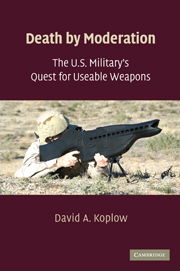Book contents
- Frontmatter
- Contents
- Preface
- Acknowledgments
- Abbreviations and Acronyms
- 1 Revolutionary Weapons and Transformed War
- 2 Deterrence and Self-Deterrence
- 3 The Law of Armed Conflict
- 4 Precision-Guided Munitions
- 5 Low-Yield Nuclear Weapons
- 6 Smart Antipersonnel Land Mines
- 7 Antisatellite Weapons
- 8 Nonlethal Weapons
- 9 What to Do about Useability
- Index
- References
2 - Deterrence and Self-Deterrence
Published online by Cambridge University Press: 05 June 2012
- Frontmatter
- Contents
- Preface
- Acknowledgments
- Abbreviations and Acronyms
- 1 Revolutionary Weapons and Transformed War
- 2 Deterrence and Self-Deterrence
- 3 The Law of Armed Conflict
- 4 Precision-Guided Munitions
- 5 Low-Yield Nuclear Weapons
- 6 Smart Antipersonnel Land Mines
- 7 Antisatellite Weapons
- 8 Nonlethal Weapons
- 9 What to Do about Useability
- Index
- References
Summary
Scenario 2
Events in and around Cuba in October 1962 brought the planet closer to World War III than at any time before or since. The superpowers ratcheted up their cold war nuclear and conventional weapons to the highest state of readiness; the diplomats stumbled through imperfect communications, misunderstood motivations, and outright deceit; and President John F. Kennedy later remarked that he personally calculated the odds on nuclear war breaking out as “between one out of three and even.”
The queasy path toward that precipice began in 1959, when Fidel Castro's revolution ousted the former dictator, Fulgencio Batista, and turned the country sharply leftward. There followed, in short order, a series of uncompensated expropriations of privately owned property, a comprehensive trade embargo imposed by the United States, and an ill-fated invasion at the Bay of Pigs – all of which drove Castro into the willing arms of the Soviet Union's Premier Nikita Khrushchev and propelled Cuba to the pinnacle of the American domestic political agenda.
In the summer of 1962, the U.S.S.R. and Cuba secretly and rapidly began construction of an elaborate set of installations across the island for a series of air fields, ground bases, surface-to-air missile sites, and – most ominous of all – launchers for nuclear-armed ballistic missiles. Up to 42 medium-range (2000 km) SS-4 missiles and 24 intermediate-range (4000 km) SS-5 missiles were planned; these would be capable of holding at risk most of the population of the continental United States, with flight times of only 20 minutes or less.
- Type
- Chapter
- Information
- Death by ModerationThe U.S. Military's Quest for Useable Weapons, pp. 28 - 54Publisher: Cambridge University PressPrint publication year: 2009



